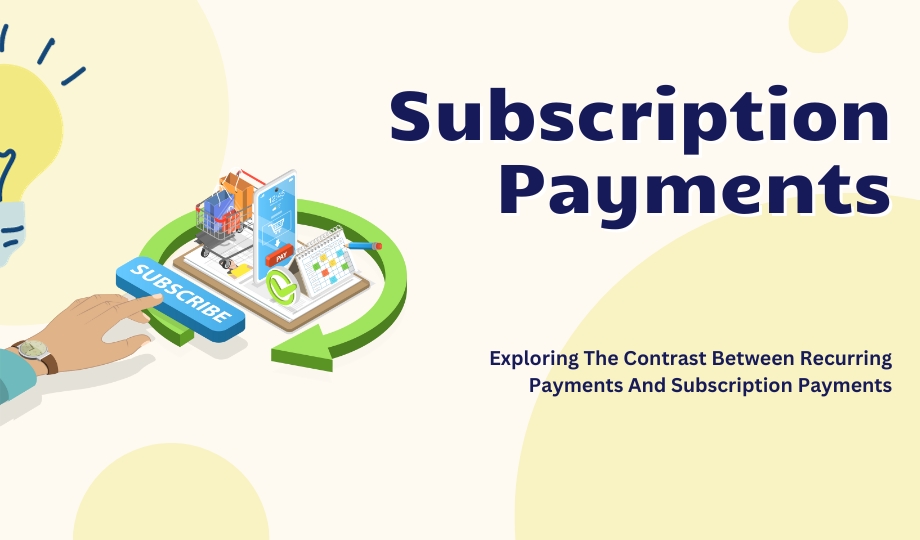Web Technology Expert (formerly Web technology expert) delves into the distinctions between recurring payments and subscription payments. These two pricing models are commonplace in today’s business landscape, each offering unique advantages for businesses and their customers. Let’s break down these models and examine their benefits.
Recurring Payments:
Recurring payments, often referred to as automatic or recurring billing, are a business model in which customers authorize the service or product provider to charge them at regular intervals (monthly, weekly, daily, or annually). This automated approach simplifies the process for both businesses and customers. Customers continue to receive the product or service until they choose to cancel the subscription or until the recurring payment plan expires, without the need to place an order or make service requests for every transaction.
Examples of Recurring Payments:
Many renowned service-based brands employ recurring payment models, including giants like Netflix, Spotify, Dropbox, digital magazines, Salesforce, and various software and digital service providers. Even entities such as gyms, libraries, or club memberships rely on recurring payment systems.
How Recurring Payments Function:
Recurring payments are automatically debited from customers’ bank accounts on predefined schedules, with multiple payment methods accepted, including debit cards, credit cards, UPI, internet bank transfers, and more. To facilitate these payments, businesses require a merchant account with a payment service provider. The payment amount is initially deposited into the merchant account and then transferred to the business’s bank account.
Note:
A merchant account is established with the payment gateway provider to facilitate transactions.
The payment service provider manages the entire payment processing workflow, collecting payments on behalf of merchants, securely processing them, and depositing the funds into the merchant’s account. While there may be slight variations among different payment processors, the fundamental framework remains consistent.
Types of Recurring Payments:
Recurring payments fall into two categories:
Regular or Fixed Recurring Payments: In this category, customers are charged a consistent amount at regular intervals (weekly, monthly, or yearly), making it suitable for streaming services, memberships, and the like.
Irregular or Variable Payments: Here, the payment amount varies based on the customer’s usage of the product or service, ideal for bills like electricity, groceries, or other utilities.
Advantages of Recurring Payments:
Recurring payments offer several advantages:
Enhanced Customer Retention: Recurring payments build trust and promote customer loyalty by providing a convenient and automated means of receiving goods or services.
Ensured Prompt Payment: These payments eliminate the risk of late payments, ensuring a positive customer-business relationship.
Predictable Cash Flow: Businesses can rely on a consistent and predictable cash flow, avoiding revenue uncertainty.
Time-Saving for Customers: Customers need to provide payment information only once, saving them the time and effort of repeated transactions.
Reduced Billing and Collection Costs: Automated recurring payments reduce expenses associated with payment processing and manual invoicing.
Subscription Payments:
Subscription payments share similarities with recurring payments, as money is automatically debited from the customer’s account to the merchant account at fixed intervals (monthly, weekly, or annually). Subscription businesses have the flexibility to create various plans and pricing structures, tailored to market demands. This flexibility extends to plan lengths and billing intervals, accommodating customer preferences.
Advantages of Subscription Payments:
Benefits of subscription payments include:
Payment Flexibility: Subscription payment systems allow businesses to offer multiple payment options, enhancing flexibility and the customer experience.
Regulated Cash Flow: These payments contribute to predictable and fixed monthly revenue, reducing gaps between billing cycles.
Customer Attraction: Subscription models attract more customers by offering the convenience of spreading payments over smaller installments.
Recurring Payments vs. Subscription Payments:
While recurring and subscription payment models share numerous benefits, there are subtle differences to consider. Subscription businesses have the advantage of offering multiple pricing plans, allowing customers to switch between plans as needed. Recurring billing, in contrast, maintains a consistent billing mechanism regardless of the pricing plan.
Conclusion:
Both recurring and subscription-based pricing models simplify transactions for businesses and customers alike. If your business necessitates recurrent payments, choosing between these models should depend on your specific customer requirements and preferences.

